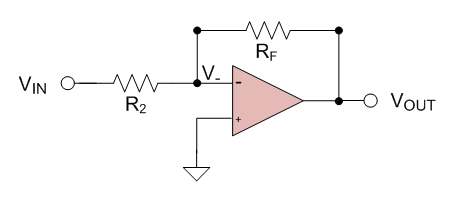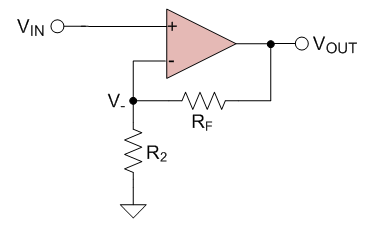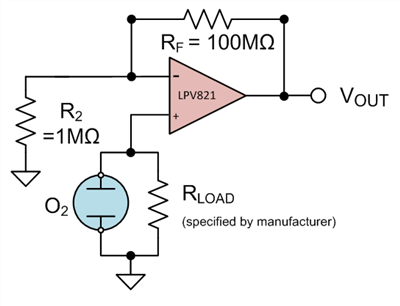|
The OP
Published on 2019-6-23 22:41
Only look at the author
This post is from Analogue and Mixed Signal
| ||
|
|
||
- 【Posts】DC Gain of Nanopower Op Amps
- 【Posts】Current Sensing Using Nanopower Op Amps
- 【Posts】5V_28MHZ bandwidth precision CMOS low noise low distortion operational amplifier rail-to-rail constant gain
- 【Posts】Application Solution | D358 high-gain operational amplifier can be used in audio amplifiers, industrial control and other products
- 【Posts】High voltage power supply problem, 220V AC input, 10~500V DC output
- 【Posts】What microcontroller is used in car keys? Why is the power consumption so low?
- 【Posts】The brushless DC motor suddenly reverses when it is rotating forward, burning out the MOS tube relay
- 【Posts】The DC power supply output voltage is unstable. How to calibrate and test it?
- 【Download】【TI】Nanowatt power touch screen controller with SPI serial interface
- 【Download】An overview of how to design a micropower rail-to-rail output class AB operational amplifier
- 【Download】The concept of effective bandwidth and gain-bandwidth product of operational amplifier
- 【Download】Design of a low voltage, high gain bandwidth CMOS folded cascode operational amplifier
- 【Download】10KWh Lithium Battery DC Microgrid Platform Project Technical Solution
- 【Download】ADI\'s micropower toxic gas detection solution based on electrochemical sensors
- 【Download】Analog electronics course design, series DC regulated power supply: design tasks and requirements; design and manufacture a series DC regulated power supply composed of transistors and integrated operational amplifiers.
- 【Download】Hangzhou Jiemaowei ultra-low power real-time clock GM1381, compatible with HT1381, chip manual and reference source code
- 【Design】Application circuit of low-power operational amplifier TC75S102F
- 【Design】#the4thLichuangcompetition# Passive micro-power dynamic AC current detection PLC signal acquisition, protection and linkage control
- 【Design】Ultra-low standby power less than 90mW auxiliary AC/DC power supply reference design
- 【Design】48V dynamic microphone gainer
- 【Design】5.8G image transmission high gain antenna
- 【Design】NCP2809BGEVB: Stereo Audio Amplifier with Adjustable External Gain Evaluation Board
- 【Circuits】OP196/296/496 type micro power supply positive and negative limited input and output operational amplifier
- 【Circuits】Digitally controlled operational amplifier gain circuit
- 【Circuits】Single potentiometer gain-adjustable op amp
- 【Circuits】Variable gain operational amplifier circuit diagram
- 【Circuits】Gain programmable amplifier circuit using wideband switching input operational amplifier OPA676
- 【Circuits】Variable Gain and Sign Op Amp
- 【Articles】STMicroelectronics operational amplifiers have low offset, zero temperature drift, and wide gain bandwidth to improve measurement accuracy.
- 【Articles】Simulating Gain-Bandwidth with an Operational Amplifier Model
- 【Articles】Engineers share their expertise: Op amp gain error design guidelines
- 【Articles】Digitally Controlled Gain Operational Amplifier
- 【Articles】Open-loop gain of an operational amplifier
- 【Articles】Design and implementation of high-speed CMOS operational amplifier based on gain enhancement technology
-
Current Sensing Using Nanopower Op Amps
Designersimplementcurrentsensingforsystemprotectionandmonitoringbyplacingaverysmall"shunt"resistorinserieswiththeloadandacurrentsenseamplifieroropampbetweenthetwo Therearetwolocationstoplacetheshuntresistordependingontheload:betweenthelo ...
-
Current Sensing Using Nanopower Op Amps
Designersimplementcurrentsensingforsystemprotectionandmonitoringbyplacingaverysmall"shunt"resistorinserieswiththeloadandacurrentsenseamplifieroropampbetweenthetwo Therearetwolocationstoplacetheshuntresistordependingontheload:betweenthelo ...
-
[Review of "Artificial Intelligence Practical Tutorial"] Python Function
#【《ArtificialIntelligencePracticeTutorial》Evaluation】PythonFunction##FunctionIfablockofcodeisneededmultipletimeswhendevelopingaprogram,butinordertoimprovetheefficiencyofwritingandthereuseofcode,thecodeblockswithindependentfunctionsareor ...
- Help! My newly bought power bank is broken!
- I have a question about the network port circuit?
- Four major reasons for the heating of power modules
- [Erha Image Recognition Artificial Intelligence Vision Sensor] 3. Serial communication with the processor
- (Paid Purchase) SSRP-7.25 Motherboard PCB
- In-depth analysis: three types of analog front-end analog/digital converters
- LCR parallel resonance
EEWorld Datasheet Technical Support
-
"Cross-chip" quantum entanglement helps build more powerful quantum computing capabilities
IBM scientists have achieved "cross-chip" quantum entanglement - successfully entangled two "Eagl
-
Ultrasound patch can continuously and noninvasively monitor blood pressure
A research team at the University of California, San Diego, has developed an innovative wearable
-
Europe's three largest chip giants re-examine their supply chains
At the Electronica 2024 CEO Roundtable held just last week, the CEOs of three chip giants, Infine
- It is reported that Kioxia will be approved for listing as early as tomorrow, and its market value is expected to reach 750 billion yen
- The US government finalizes a $1.5 billion CHIPS Act subsidy to GlobalFoundries to support the latter's expansion of production capacity in the US
- SK Hynix announces mass production of the world's highest 321-layer 1Tb TLC 4D NAND flash memory, plans to ship it in the first half of 2025
- UWB is a new way to use it in cars. Can wireless BMS also use it?
- Filling the domestic gap! China Mobile, Huawei and others jointly released the first GSE DPU chip
- Samsung Electronics NRD-K Semiconductor R&D Complex to import ASML High NA EUV lithography equipment
- Apple reveals the secret of its own chip success: competitors can't use the latest cutting-edge technology
- Problems with STM32 and passive buzzer playing sound
- Embedded Tutorial_DSP Technology_DSP Experiment Box Operation Tutorial: 2-28 Building a Lightweight WEB Server Experiment
- OPA847IDBVR op amp domestic replacement
- AG32VF407 Test UART
- [Digi-Key Follow Me Issue 2] Chapter 1: Sharing on receiving the goods
- What model is this infrared receiver? Which model can be used instead? Thank you
- Selling brand new unopened ZYNQ 7Z020 FPGA core board
- The LORA module used in the lithium battery-powered water meter setting can save energy when 100 water meters are installed in one corridor.
- I would like to ask, when a port is set to RX0, is it necessary to set the input and output direction of this port?
- Why is this year so difficult? It’s even more difficult than during the pandemic. I’m 30 and facing unemployment. I’m so confused.
- Ask about the voltage regulator test question
- [Xiaohua HC32F448 Review] About Xiaohua Semiconductor's UART interrupt sending and PRINTF construction and redirection
- 【BIGTREETECH PI development board】 HDMI output test
- 【BIGTREETECH PI development board】+08. Audio test (zmj)
- [Xiaohua HC32F448 Review] +RTC electronic clock
- 有奖直播报名| 高可靠性IGBT新选择 —— 安世半导体650V IGBT
- 【直播时间】12月19日(周四)下午15:00-16:30
【直播好礼】定制双肩商务包、30元京东卡、吸管玻璃杯
- 安世半导体直播报名中
- 直播主题:安世半导体理想二极管与负载开关,保障物联网应用的稳健高效运行
直播时间:12月17日(周二)下午14:00
报名就有机会获得:定制双肩商务包、30元京东卡、吸管玻璃杯
- PI 电源小课堂 | 无 DC-DC 变换实现多路高精度输出反激电源
- 时间:即日起-12月15日
看视频学习电源干货,答题赢取京东卡!
- 参会有好礼 | 2024 瑞萨电子MCU/MPU工业技术研讨会
- 深圳站:11月30日(周六)深圳湾万怡酒店
上海站:12月06日(周五)上海喜玛拉雅酒店
奖励设置:现金红包、螺丝刀套装或30元京东卡
- Littelfuse 新品赋能电子产品安全可靠并高效, 10+挑战等你探索!
- Littelfuse 应用赋能星球,覆盖了诸多应用痛点及解决办法,邀请工程师一起探索,解锁更多设计力!
- 下载资料赢好礼!看Vicor模块化电源解决方案如何推动创新
- 活动时间:即日起-2024年12月31日
如何参与:点击活动页内您想了解的模块,找到资料下载即可参与抽奖,活动结束后统一发奖!
- 有奖活动|英飞凌高密度双相电源模块为高性能运算平台而生
- 活动时间:即日起-12月15日
活动奖励:蓝牙音箱、氮化镓充电器套装、黑色小背包
- 本周精选下载推荐:电源管理基础Dummies
- 本周小编给大家带来一本超简单、超干货的电子书——《电源管理基础Dummies》!内容深入浅出,排版舒服简洁,分分钟能get到电源管理最核心的知识内容。
EEWorld
subscription
account

EEWorld
service
account

Automotive
development
circle

About Us Customer Service Contact Information Datasheet Sitemap LatestNews
- I want to get started with FPGA signal processing, what should I do?
- I want to get started with FPGA, what should I do?
- I want to get started with machine learning in a very simple way, what should I do?
- Please recommend some PCB introductory tutorials
- Please recommend some PICC microcontroller introductory tutorials
- Please recommend some introductory tutorials on smt programming
- For the introduction to deep learning experiments, please give a learning outline
- How to get started with FPGA
- What is a microcontroller?
- What is the Internet of Things?


 Room 1530, Zhongguancun MOOC Times Building,
Block B, 18 Zhongguancun Street, Haidian District,
Beijing 100190, China
Tel:(010)82350740
Postcode:100190
Room 1530, Zhongguancun MOOC Times Building,
Block B, 18 Zhongguancun Street, Haidian District,
Beijing 100190, China
Tel:(010)82350740
Postcode:100190
 京公网安备 11010802033920号
京公网安备 11010802033920号













 提升卡
提升卡 变色卡
变色卡 千斤顶
千斤顶